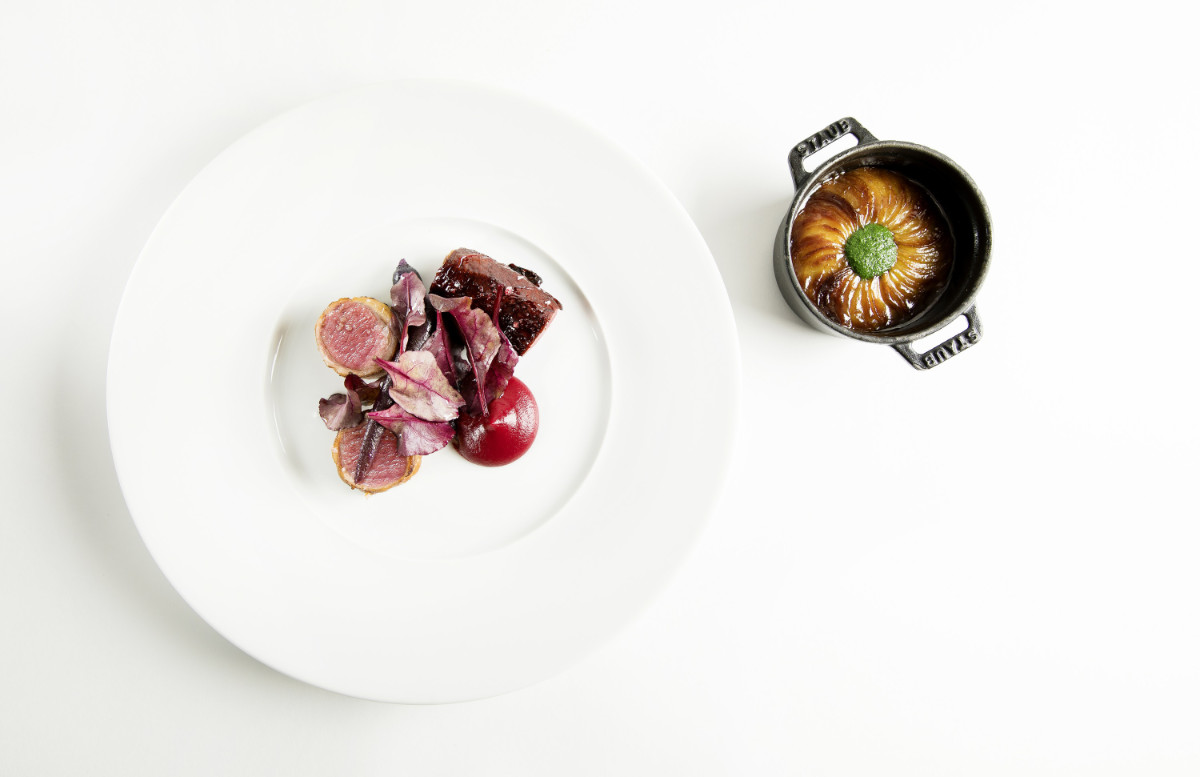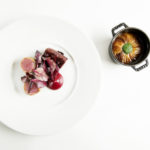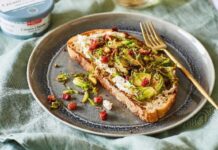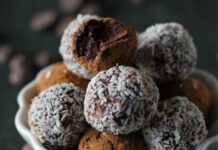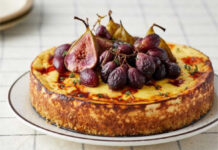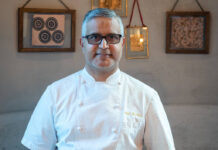Don’t be overwhelmed by the length of the recipe, chef Jason Atherton is more interested in inspiring home cooks than having them replicate his restaurant standard recipes exactly – but if you’ve got the kitchen skills, why not give it a go?
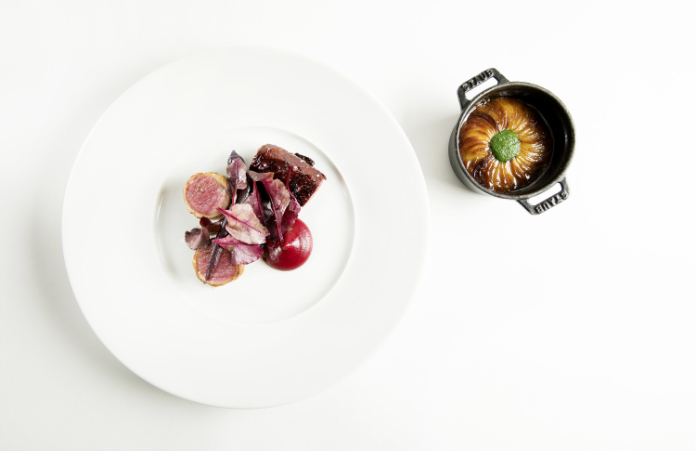
Winter Lake District lamb with beetroot and blackcurrant purée
Ingredients
- 2 boned short saddles of lamb about 475g each (loins and fillets separated)
- meat glue for dusting
- olive oil for cooking
- sprigs of rosemary
- unsalted butter for cooking
- maldon sea salt
- black pepper
For the lamb hotpot
- 100 g gros sel (grey sea salt)
- a few sprigs of thyme leaves picked
- 1 garlic clove large
- 20 g grated lemon zest
- 1 boned shoulder of lamb about 2kg
- olive oil for cooking
- 200 g lamb fat
- 4 large carrots
- 4 turnips
- 500 g baby silverskin onions peeled
- 1 l Lamb Sauce
- 2 large Desirée potatoes
- 125 g clarified butter melted
For the beetroot-stained cabbage
- 1 Hispi cabbage
- 1 bottle beetroot juice (we use ‘Beet It’)
For the beetroot and blackcurrant puree
- 7 purple beetroots
- 250 g blackcurrants
- 150 ml red wine
- 150 ml port
- 50 ml raspberry vinegar
For the purple carrots
- 2 bunches of baby purple carrots trimmed
- a few knobs of unsalted butter
To serve
- a handful of baby bull’s blood leaves with stems on
- vinaigrette
- mint sauce
Method
- Trim off any sinews from the fillets, then set aside in the fridge. Carefully cut off the fat covering the loins so that the fat remains as whole pieces. Lay out the fat on a chopping board and bang the pieces with a rolling pin to flatten them out. Arrange the pieces of fat side by side on a large sheet of clingfilm to make a rectangle large enough to wrap around the loins. Rub the loins with a little salt. Sprinkle a little meat glue on the rectangle of fat, then place the loins along one side. Holding the ends of the clingfilm, roll up to wrap the fat around the loins and form a neat log. Unwrap the clingfilm, then tie the loin ballotine with butcher’s string.
- Put the loin ballotine into a large vacuum bag and vacuum-seal it. Set the bag on a steaming tray and place in a steam oven to cook for 5 minutes. Remove and immediately immerse the vacuum bag in a bowl or tray of iced water to stop the cooking process. Keep in the fridge until needed.
- When ready to finish the loins for serving, preheat the oven to 200°C/180°C fan/Gas Mark 6. Heat a little olive oil in an ovenproof frying or sauté pan and sear the loin ballotine for 2 minutes on each side or until evenly browned. Add some rosemary to the pan, then transfer to the oven and roast for a couple of minutes for medium rare. Leave to rest for a few minutes before serving.
- To cook the lamb fillets for serving, heat a little oil in a wide frying pan. Season the fillets with a little salt and pepper, then add them to the pan with some rosemary and butter. Sear for about 2 minutes on each side or until evenly golden brown. As they cook, spoon the foaming butter over them to keep them moist and encourage even cooking. When ready, remove the from the heat and allow to rest for a few minutes.
- Start by making a salt cure. Put the salt, thyme leaves, peeled garlic and lemon zest in a small food processor and blitz together. Tip half the mixture on to a baking tray. Place the shoulder of lamb on the tray and sprinkle the remaining salt cure over the top. Rub the cure all over the lamb with your hands. Cover the tray with clingfilm and set aside in the fridge to cure for 4 hours.
- Rinse off the salt cure from the lamb shoulder and pat it dry with kitchen paper. Heat a little olive oil in a large pan over a medium-high heat and sear the lamb shoulder for about 2 minutes on each side or until evenly golden brown. Remove to a tray and leave to cool. Once cooled, put the lamb shoulder into a vacuum bag and add the lamb fat. Vacuum-seal the bag, then gently cook the lamb in a sous vide machine (or water bath) heated to 84°C for 8–10 hours. When ready, the lamb should be soft and tender. Remove from the sous vide and leave to cool completely in the bag to prevent the lamb from drying out.
- Meanwhile, peel the carrots and turnips and chop into roughly 2cm dice. Heat a little olive oil in a large heavy-based pan over a medium-high heat. Add the carrots, turnips and onions with a little seasoning and fry the vegetables, stirring occasionally, for 8–10 minutes or until tender and golden brown.
- Roughly chop the lamb shoulder into 2cm dice. Add to the pan along with the lamb sauce and season well to taste. As soon as the mixture is heated through, remove the pan from the heat. Spoon the lamb mixture into 4–6 individual ovenproof serving pots.
- Peel the potatoes and thinly slice them on a mandoline. Pile the slices into short stacks and stamp out neat discs with a 3cm round pastry cutter. Working quickly, before they discolour, arrange the potato discs, overlapping, on top of the lamb mixture in each individual pot. Brush the potatoes generously with clarified butter and season well with sea salt.
- When ready to serve, preheat the oven to 160°C/140°C fan/Gas Mark 3. Place the pots on a baking sheet and bake for 15 minutes, turning the pots every 5 minutes to ensure that the potatoes colour evenly. The lamb hotpots are done when the potatoes are golden brown and tender when pierced with a skewer or the tip of a knife.
- For the beetroot-stained cabbage, trim off the base of the cabbage and separate the leaves. Trim the hard stalk from each leaf, then place the leaves in a pan. Pour over the beetroot juice and bring to a simmer. Partially cover the pan with a lid and simmer for 4–5 minutes or until the cabbage leaves are tender and stained purple colour. Leave to cool completely in the juice.
- For the beetroot and blackcurrant puree, peel and coarsely grate the beetroots, then place in a pan with all the other ingredients. Bring to a vigorous boil and cook, stirring the mixture every once in a while, until the beetroot is soft and the mixture has reduced to the consistency of jam. Transfer the contents of the pan to a blender and blitz until smooth. Season to taste. Pass the purée through a fine sieve into a clean pan, ready to reheat for serving.
- Blanch the carrots in a pan of boiling salted water for about 3 minutes or until they are tender when pierced with the tip of a knife. Use tongs or a slotted spoon to transfer the carrots to a bowl of iced water to cool them quickly and preserve their colour. When you are about ready to serve, lightly season the carrots, then reheat them in a pan of foaming butter for a couple of minutes, tossing occasionally, until warmed through.
- To serve, slice the lamb loin ballotine thickly and place 2 slices on each serving plate. Cut the lamb fillets into individual portions and wrap each portion in 1–2 beetroot-stained cabbage leaves. Add this to each plate followed by a neat spoonful of beetroot and blackcurrant purée and a couple of purple carrots. Dress the baby bull’s blood leaves with a little vinaigrette and garnish the plate with a few leaves. Bring the dish to the table with an individual lamb hotpot and a small serving jug of mint sauce on the side.
Nutrition
Pollen Street The Cookbook by Jason Atherton is published by Absolute Press.
You may also be interested in…
This article may include affiliate links to products and services where we may receive a small fee to support the running of this site if you make a purchase or is a sponsored article from one of our select editorial partners providing valuable advice and information to our readers.























































